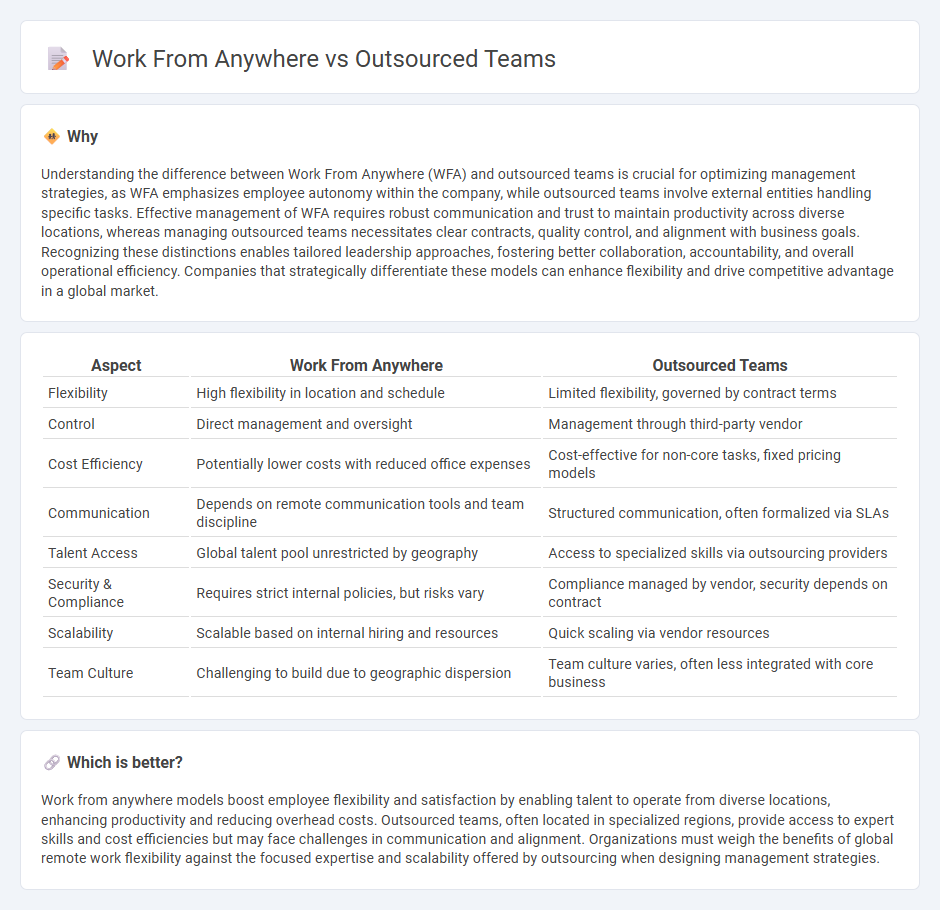
Management strategies differ significantly between work-from-anywhere models and outsourced teams, focusing on flexibility versus cost-efficiency respectively. Work-from-anywhere allows organizations to tap into global talent pools while maintaining direct control and cultural alignment. Explore more about optimizing management approaches for these evolving workforce models.
Why it is important
Understanding the difference between Work From Anywhere (WFA) and outsourced teams is crucial for optimizing management strategies, as WFA emphasizes employee autonomy within the company, while outsourced teams involve external entities handling specific tasks. Effective management of WFA requires robust communication and trust to maintain productivity across diverse locations, whereas managing outsourced teams necessitates clear contracts, quality control, and alignment with business goals. Recognizing these distinctions enables tailored leadership approaches, fostering better collaboration, accountability, and overall operational efficiency. Companies that strategically differentiate these models can enhance flexibility and drive competitive advantage in a global market.
Comparison Table
| Aspect | Work From Anywhere | Outsourced Teams |
|---|---|---|
| Flexibility | High flexibility in location and schedule | Limited flexibility, governed by contract terms |
| Control | Direct management and oversight | Management through third-party vendor |
| Cost Efficiency | Potentially lower costs with reduced office expenses | Cost-effective for non-core tasks, fixed pricing models |
| Communication | Depends on remote communication tools and team discipline | Structured communication, often formalized via SLAs |
| Talent Access | Global talent pool unrestricted by geography | Access to specialized skills via outsourcing providers |
| Security & Compliance | Requires strict internal policies, but risks vary | Compliance managed by vendor, security depends on contract |
| Scalability | Scalable based on internal hiring and resources | Quick scaling via vendor resources |
| Team Culture | Challenging to build due to geographic dispersion | Team culture varies, often less integrated with core business |
Which is better?
Work from anywhere models boost employee flexibility and satisfaction by enabling talent to operate from diverse locations, enhancing productivity and reducing overhead costs. Outsourced teams, often located in specialized regions, provide access to expert skills and cost efficiencies but may face challenges in communication and alignment. Organizations must weigh the benefits of global remote work flexibility against the focused expertise and scalability offered by outsourcing when designing management strategies.
Connection
Work from anywhere policies enhance global talent acquisition by enabling seamless collaboration with outsourced teams across multiple time zones. This approach leverages digital communication tools and project management software to optimize productivity and reduce operational costs. Companies benefit from increased flexibility, access to diverse skills, and scalable staffing solutions through the integration of remote work and outsourcing strategies.
Key Terms
Coordination
Outsourced teams provide structured coordination through dedicated management and predefined workflows, ensuring alignment with project goals and deadlines. Work from anywhere models rely heavily on robust communication tools and flexible schedules to maintain productivity but may face challenges in synchronizing tasks across diverse time zones. Explore effective strategies to enhance coordination in both models and boost team performance.
Communication
Outsourced teams often face challenges in communication due to time zone differences and cultural barriers, which can impact project collaboration and efficiency. Work-from-anywhere models leverage flexible technology and real-time communication tools to foster seamless interaction, enhancing productivity despite geographic dispersion. Explore effective strategies to optimize communication and maximize team performance in both setups.
Accountability
Outsourced teams provide structured accountability through clear contractual agreements and defined deliverables, ensuring performance metrics are met consistently. Work from anywhere models emphasize individual responsibility and self-management, relying heavily on trust and digital communication tools to maintain accountability across dispersed environments. Explore how different organizational strategies enhance accountability in flexible work arrangements to optimize productivity and outcomes.
Source and External Links
In-House vs. Outsourced Teams: Which Option Best Suits Your ... - Outsourced teams offer flexibility, cost savings, access to global specialist skills, and faster project completion compared to in-house teams, which provide stability and local control but have limited talent pools and longer onboarding times.
Effective Outsourced Team Management Strategies - Success with outsourced teams depends on clear goals, defined roles, communication, use of technology, regular monitoring, cultural awareness, and fostering a positive culture to enhance engagement and resolve conflicts.
The transformative impact of building outsourced teams that feel in-house teams - Strategically integrating outsourced teams with in-house operations can reduce costs, improve performance, and build a resilient, dynamic talent strategy that enhances innovation and operational efficiency.
 dowidth.com
dowidth.com